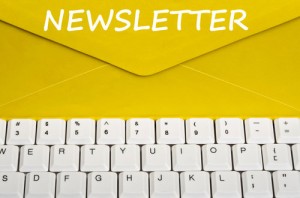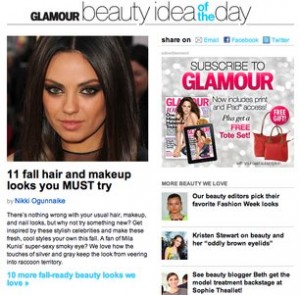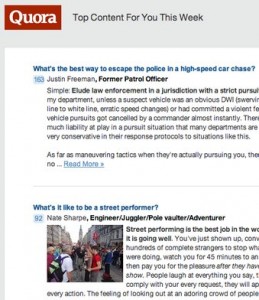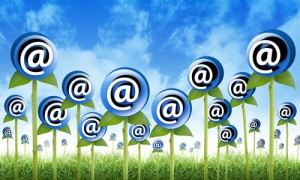Brands
Kick Spam to the Curb: How to Get Newsletters Right
In the marketing world, email has a less-than-stellar reputation. It all began with the good old days of snail mail when somebody came up with the brilliant idea to stuff residential mailboxes with relentless junk.
 Shove pages and pages of advertisements and coupons in peoples’ faces, and they’ll love it, right? Wrong, wrong, and wrong.
Shove pages and pages of advertisements and coupons in peoples’ faces, and they’ll love it, right? Wrong, wrong, and wrong.
Naturally, this horrible marketing practice found a new home online. Email advertising became synonymous with junk. Spam folders grew bigger than inboxes, inspiring content marketers to redirect their efforts to more consumer friendly channels like blogs and social media.
But email marketing isn’t all bad. In fact, newsletters are some of the most user friendly and valuable channels for reaching potential customers. People actually want this stuff — kind of like a free magazine subscription (to continue to the snail mail analogy).
Here are strategies for building truly exceptional newsletter campaigns.
Content + Trust = Priority 1
For inspiration, consult Glamour Magazine’s newsletter. On a regular basis, they send subscribers handcrafted newsletters with makeup, fashion, and health advice.
 It’s like getting a free mini-magazine as a refreshing mental health break — remember that Glamour’s paper version is something that people pay for. Spam is nowhere in sight.
It’s like getting a free mini-magazine as a refreshing mental health break — remember that Glamour’s paper version is something that people pay for. Spam is nowhere in sight.
“Remember, the success of any email marketing program depends on genuinely compelling content,” Sonia Simone wrote in a Copyblogger post. “You want your readers to dig through spam filters, complain to their email providers, and do anything they can to make sure they’re getting your content.”
So give people something that they genuinely want to get — rock star content.
Become Needed by Simplifying Information
As a case study, check out Contently’s Freelance Strategist Blog. Every week, the editors send a newsletter roundup of quality content worth checking out.
 The value proposition is two-fold: (1) freelance writers are frequently busy and lack the time to read about writing and (2) freelance writers need a consistent collection of business information to improve their workflow.
The value proposition is two-fold: (1) freelance writers are frequently busy and lack the time to read about writing and (2) freelance writers need a consistent collection of business information to improve their workflow.
For self-employed people, wasted time can be brutal. The Freelance Strategist fills a much needed information gap to help writers make more with their time.
“Understanding the emotional and logical mental process of your readers is the best way to take your email signups to the next level,” according to The Blog Tyrant in a post for Copyblogger.
Give Subscribers Offers that They Can’t Refuse
Udemy is one of the Internet’s biggest learning communities. Using the platform, people can create, host, and sign up for courses on topics ranging from programming to web design and entrepreneurship.
 Its marketing goals are simple and direct: Get people to sign up for more classes.
Its marketing goals are simple and direct: Get people to sign up for more classes.
Udemy leverages email as a channel to encourage more signups. Rather than sending mass blasts, the company sends custom messages based on subscribers’ interests.
With subject headings like “You’ve Been Saying You Want to Learn jQuery for Months,” Udemy’s newsletters are powerful sales tools that connect audiences with products that care about.
“Selling existing customers add-on or complementary products and services pays off,” wrote Hubspot’s Lindsey Kirchoff in a blog post about email marketing.
Connect the Dots With Social
Question-and-answer discussion community Quora has integrated email with its social media platform. Every so often, the website sends subscribers questions that they might find enjoyable.
 The newsletter design is straightforward and heavily focused around the conversation that Quora is featuring. It’s not about driving clicks, visits, or sales. Rather, for Quora, email marketing inspires community dialogue.
The newsletter design is straightforward and heavily focused around the conversation that Quora is featuring. It’s not about driving clicks, visits, or sales. Rather, for Quora, email marketing inspires community dialogue.
“Another great way to cross-pollinate email marketing and social media is to highlight a particular tweet in your email campaign,” wrote DJ Waldow in a Social Media Examiner Blog Post.
Who says that email needs to be an isolating experience? Leverage email to build a customer community.
Final Thoughts: Learn More from Unsubscribes
No matter how awesome a newsletter turns out, unsubscribes are inevitable. It’s the perfect opportunity to find out what’s wrong and to carve out an action plan for improvement.
 “When a reader unsubscribes, ask why and get their feedback,” wrote Zach Bulygo in the KISSmetrics blog. “If it’s because you email too often, it may be a hint that you should give readers an option to receive email a little less frequently … This could help you from losing them as a subscriber.”
“When a reader unsubscribes, ask why and get their feedback,” wrote Zach Bulygo in the KISSmetrics blog. “If it’s because you email too often, it may be a hint that you should give readers an option to receive email a little less frequently … This could help you from losing them as a subscriber.”
Content marketing is about open dialogue — the same goes for newsletters.
Image courtesy of FuzzBones/Shutterstock, Angela Waye/Shutterstock
Get better at your job right now.
Read our monthly newsletter to master content marketing. It’s made for marketers, creators, and everyone in between.




